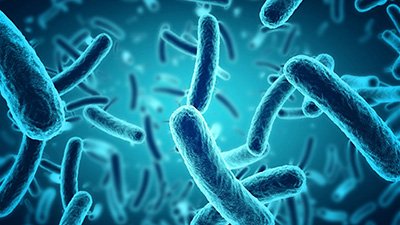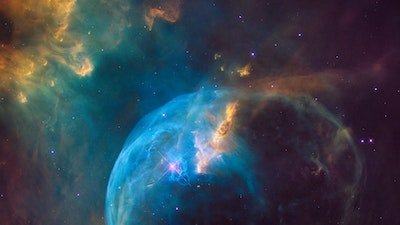Origins of Multicellular Organisms
One of the problems inherent in the evolutionary dogma is going from a single-celled organism, once such a thing exists, to a multi-celled organism. Evolutionists have proposed all sorts of outlandish ideas to solve this predicament, but none of them have been workable. However, because their worldview requires this evolution to occur, they continuously search for a mechanism to go from single-celled to multi-celled.
In other words, multicellular organisms did not evolve from simple balls of cells, as evolutionists have long proclaimed.
The standard model presented in secular textbooks claims that primitive sponges were the first multi-celled organisms, arising from colonial organisms.1 There is some disagreement about exactly when this occurred. Astrobiology magazine claims it happened about 600 million years ago2, while an article published in Nature claimed it occurred 2 billion years ago.3 Regardless of the quibbles over imaginary time, this consensus on colonial organisms giving rise to multicellularity has recently been challenged by a study in Nature (2019). The authors examined sponges and single-celled organisms and discovered that the “. . . transcriptomes, development and behavior (of the two) provides no support for the long-standing hypothesis that multicellular animals evolved from an ancestor that was an undifferentiated ball of cells resembling extant choanocytes and choanoflagellates.”4 In other words, multicellular organisms did not evolve from simple balls of cells, as evolutionists have long proclaimed.
This discovery is earth shattering for the evolutionary dogma. Previous ideas of multicellular evolution almost exclusively included evolution from the aforementioned “undifferentiated ball of cells.” One article had proposed that predation caused unicellular organisms to clump together and eventually evolve into multicellular organisms.5 Another article had looked at Volvox (a genus of algae that form spherical colonies) and concluded that, once colonial life evolved, specialization would be selected for within the colony leading eventually to a single, multicellular organism.6 Yet another set of authors even claimed (2012) the exact opposite of the 2019 study saying that “Choanoflagellates, the closest unicellular ancestor to animals, can form multicellular colonies through post-division adhesion, raising the possibility that a similar step was instrumental in the evolution of animal multicellularity.”7 This means that because supposed sponge-cell-ancestors can form multicellular groups, they could have been a precursor of multicellular evolution.
Flipping the Script
The authors of the Nature paper reject the colonial approach to multicellularity. Instead, they propose something completely different: “As an alternative, we posit that the ancestral metazoan cell type had the capacity to exist in and transition between multiple cell states in a manner similar to modern transdifferentiating and stem cells.”8 In other words, these researchers are proposing that the first multicellular organisms were not formed from balls of cells. Instead, they were formed from cells similar to stem cells that had the ability to differentiate into different functions. This is a radical idea in the evolutionary dogma. It overturns the entire evolutionary paradigm.
It gets worse. Along with doing yet another rewrite on the evolutionary dogma, this study also increases the difficulty of getting a multicellular organism by orders of magnitude. In order to understand why this is, it is necessary to understand some things about stem cells first.
Stem Cell Complexity
Stem cells are well known to the medical profession. They are cells that can differentiate into a number of different cell types. They exist to serve as repair mechanisms. Because they have not differentiated yet, they can be used to repair various things such as muscles, organs, bones, and even nervous tissue, including the brain. Scientists are experimenting with stem cells to treat many disorders. Stem cells are already in use in bone marrow transplants for patients with blood cancers such as leukemia.
It has been demonstrated that stem cells can produce new organs from a single cell.9,10 This is referred to as differentiation. The mechanism of differentiation is unclear at present, at least in the body of the organism. Scientists can cause stem cells to differentiate in the lab, but do not yet know all the mechanisms that cause them to differentiate in organisms.11 This is, at least in part, due to the extreme complexity of stem cells. One study describing stem cells reads in part, “Precise regulation of gene expression in SCs and their niche is paramount for executing the molecular programs of SC quiescence, self-renewal and lineage differentiation. Specific sets of expressed genes and epigenetic configurations underlie functional distinctions between different cell types within complex tissues, including SCs and the cellular niche components.”12 This means that stem cells have to be carefully regulated by both genomic and epigenomic mechanisms in order to ensure they function as intended.
With that background about stem cells in mind, consider what these evolutionists are proposing. They are proposing that, instead of normal, differentiated cells grouping together and eventually evolving multicellularity, highly specialized stem cells are responsible for multicellularity. Since stem cells can differentiate into numerous cell types, the evolutionists believe this would permit organisms to develop different cell types and enable them to have multiple, specialized, cells.
The origin of stem cells is a mystery to evolutionists.
A Shattered Dogma
This proposal raises some questions. How did organisms develop the ability to differentiate? Even assuming they did so, why did they? These are questions that evolutionists struggle to answer. The origin of stem cells is a mystery to evolutionists. They have proposed several hypotheses, including that stem cells arose as a result of multicellularity to foster division of labor in the cell.13 However, the author of the 2019 paper does not accept this hypothesis. Instead, he proposes that stem cells developed from flagellated cells already present in the common ancestor of all life, which was already multicellular in his view.14 However, he is assuming the standard model of evolution, a model which this most recent Nature study has flipped on its head. The newest study says that stem cells gave rise to multicellularity, not the other way around.15
Thus the evolutionary community is faced with a number of significant problems. They can no longer explain the origin of multicellularity, not that they ever had a strong explanation to begin with. Worse, because their explanation for the origin of stem cells rested on their assumptions about the origins of multicellularity, that explanation collapses too. To compound these problems, the newest research suggests that stem cells are responsible for the evolution of multicellularity when they no longer have an explanation for the origin of stem cells. The Glass House is shattering.
Of course, from a biblical perspective, none of the confusion in the evolutionary camp is surprising. They have brought it on themselves by assuming that multicellularity evolved when it has never been demonstrated to do so. Then, they are building their explanation for the evolution of stem cells, which again, has not been empirically demonstrated, on that faulty assumption. The creation explanation is that God created single-celled and multicellular organisms. Some single-celled organisms can live in colonies. Stem cells have always existed in the organisms in which they exist today, as a repair and replacement mechanism for dying cells. The stem cells would likely have been functional even before the fall as cellular death could exist prior to the fall as individual cells do not have the “breath of life.” This explanation is far more reasonable than any proposed by the evolutionary scientists.
Footnotes
- United World Colleges. “The First Multicellular Organisms?” Accessed July 10, 2019. http://planet.botany.uwc.ac.za/nisl/Biodiversity/part1_13.htm.
- Charles Q. Choi. “How Did Multicellular Life Evolve?” Astrobiology. February 5, 2015, Accessed July 10, 2019. https://www.astrobio.net/origin-and-evolution-of-life/multicellular-life-evolve/.
- Abderrazak El Albani et al. “Large colonial organisms with coordinated growth in oxygenated environments 2.1 Gyr ago.” Nature 466 (2010): 100–104. https://www.nature.com/articles/nature09166.
- Shunsuke Sogabe et al. “Pluripotency and the origin of animal multicellularity.” Nature 570 (2019): 519–525. https://www.nature.com/articles/s41586-019-1290-4.
- Martin E. Boraas, Dianne B. Seale and Joseph E. Boxhorn. “Phagotrophy by a flagellate selects for a colonial prey: A possible origin of multicellularity.” Evolutionary Ecology. 12 (1998) 153–164. http://virtuallaboratory.colorado.edu/DEVO@CU/papers/1b-Boraas1998_Article_PhagotrophyByAFlagellateSelect.pdf.
- Richard E. Michod, Yannick Viossat, Cristian A. Solari, Mathilde Hurand, and Aurora M. Nedelcu. “Life-history evolution and the origin of multicellularity.” Journal of Theoretical Biology 239 (2006): 257–272. http://www2.unb.ca/vip/papers/JTB.pdf.
- William C. Ratcliff, R. Ford Denison, Mark Borrello and Michael Travisano. “Experimental evolution of multicellularity.” Proceedings of the National Academy of Sciences 109, no. 5 (2012): 1595–1600. https://www.pnas.org/content/pnas/109/5/1595.full.pdf.
- Sogabe et al, 2019.
- Karim Si-Tayeb et al. “Highly efficient generation of human hepatocyte-like cells from induced pluripotent stem cells.” Hepatology 51, no. 1 (2010): 297–305. https://aasldpubs.onlinelibrary.wiley.com/doi/full/10.1002/hep.23354.
- Jason R. Spence. “Directed differentiation of human pluripotent stem cells into intestinal tissue in vitro.” Nature 470, no.7332 (2011): 105–109. https://www.ncbi.nlm.nih.gov/pmc/articles/PMC3033971/.
- Charles N. David. “Interstitial stem cells in Hydra: multipotency and decision making.” The International Journal of Developmental Biology 56 (2012): 489–497. http://www.ijdb.ehu.es/web/paper.php?doi=113476cd.
- Nicholas Heitman, Nivedita Saxena and Michael Rendl. “Advancing insights into stem cell niche complexities with next-generation technologies.” Current Opinion in Cell Biology 55 (2018): 87–95. https://www.ncbi.nlm.nih.gov/pubmed/30031324.
- Noriko Funayama. “The stem cell system in demosponges: Insights into the origin of somatic stem cells.” Development Growth and Differentiation 52, (2010): 1–14. https://onlinelibrary.wiley.com/doi/pdf/10.1111/j.1440-169X.2009.01162.x.
- Noriko Funayama. “The stem cell system in demosponges: suggested involvement of two types of cells: archeocytes (active stem cells) and choanocytes (food-entrapping flagellated cells)” Development genes and evolution 223, no. 1–2 (2013): 23-38. https://www.researchgate.net/profile/Noriko_Funayama/publication/232230287_The_stem_cell_system_in_demosponges_Suggested_involvement_of_two_types_of_cells_Archeocytes_active_stem_cells_and_choanocytes_food-entrapping_flagellated_cells/links/00b4952d7be4c1dd31000000/The-stem-cell-system-in-demosponges-Suggested-involvement-of-two-types-of-cells-Archeocytes-active-stem-cells-and-choanocytes-food-entrapping-flagellated-cells.pdf.
- Sogabe et al, 2019.
Recommended Resources

Answers in Genesis is an apologetics ministry, dedicated to helping Christians defend their faith and proclaim the good news of Jesus Christ.
- Customer Service 800.778.3390
- Available Monday–Friday | 9 AM–5 PM ET
- © 2025 Answers in Genesis





